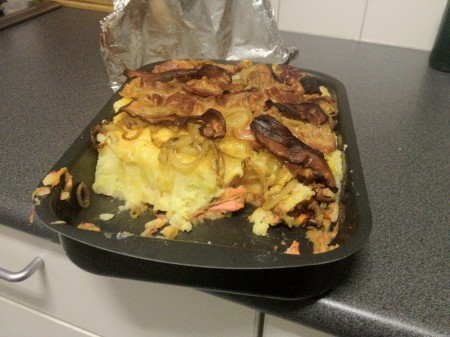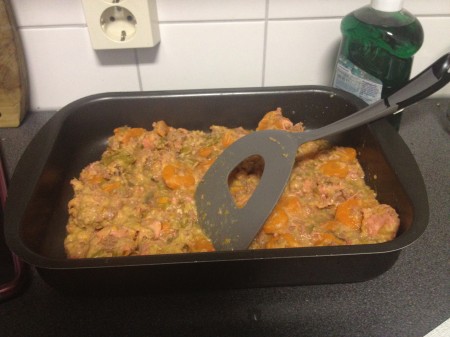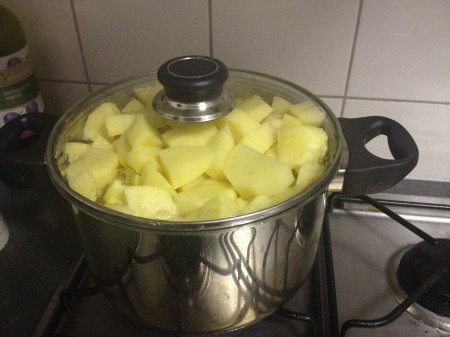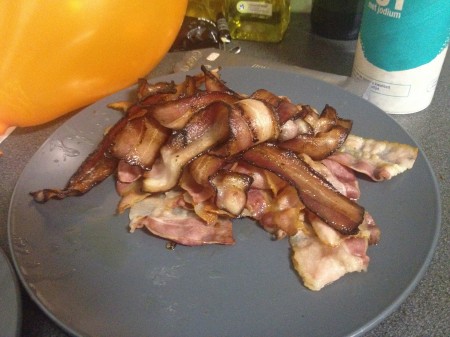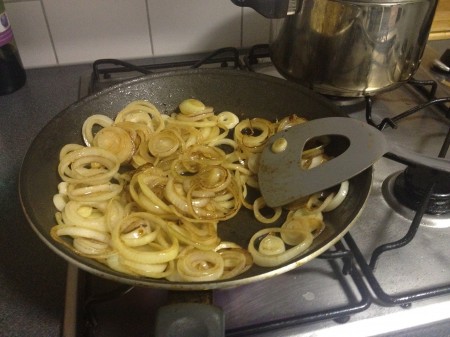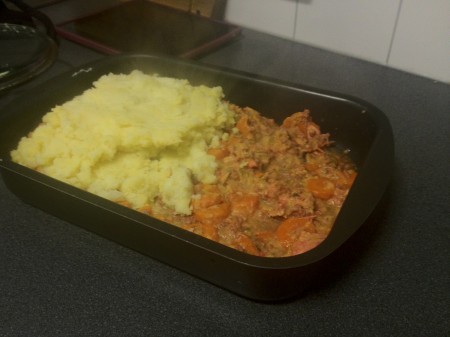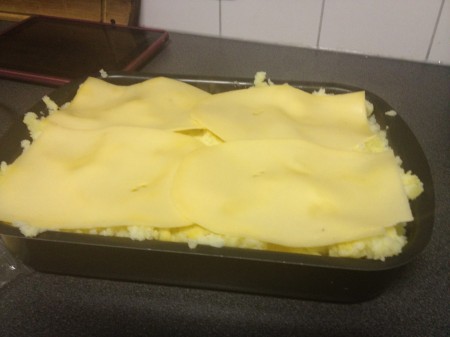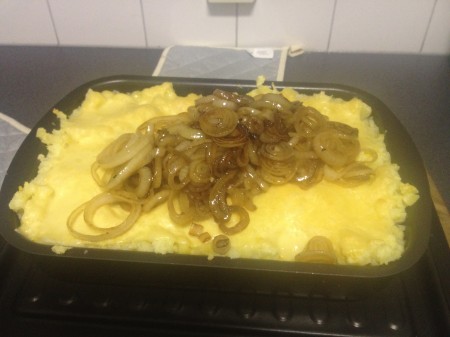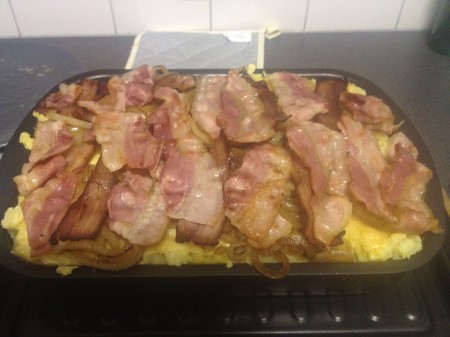1. Introduction
It is a well-known fact that certain dishes with mash and meat cover the mash with meat. One such dish is the cottage pie, which covers the mash with meat from below and another is brændende kærlighed (burning love), which covers the mash with meat from above.
The literature does not mention a dish which completely covers the mash with meat, as it should be. In this paper, we present a fusion dish, burning cottage ((In earlier iterations of this paper, we also used the name cottage pielighed to describe the dish, but recommend instead using the name burning cottage, as this name makes less use of Danglish.)), which mixes the ability of cottage pie to cover the mash with meat from below with the ability of brændende kærlighed’s ability to cover it from above. The trivial combination would leave the user with part of a dish not covered from below and a part not covered from above, but our amalgamation does not exhibit this behavior. Rather, burning cottage facilitates covering mash with meat from both above and below for the entire dish.
This solves the so-called mash/meat-equilibrium, which is a variant of the Nash equilibrium, just more delicious. The mash/meat-equilibrium states that
The mash should at all times by covered by meat on all sides in order to achieve a global optimum of the deliciousness.
To the best of our knowledge, the mash/meat-equilibrium has not been solved, and we believe that our solution, the burning cottage, to a large extent solves the mash/meat-equilibrium. The rest of this paper is structures as follows: In the next section, we introduce background material necessary for understanding the rest of this paper. In Sect. 3, we present our improved dish combining the positive traits of both cottage pie and brændende kærlighed using a cooking time less than the trivial sum. Next, we present an implementation of our approach, and in Sect. 5, we sum up our conclusions and provide directions for further cooking.
2. Background
In this section we briefly present the two dishes cottage pie and brændende kærlighed and provide algorithms and estimate cooking times for both. Cottage pie is in essence a stew, typically based on minced meat in a big pan with mash on top, whereas brændende kærlighed in essence is mash with bacon and caramelized onions on top.
2.1. Cottage Pie
To make cottage pie, one must make a stew. We regard the making of a stew as outside of the scope of this paper, but refer the interested reader to the paper by BBC in which the initial steps of the cottage pie is described. In the rest of this paper we assume that some stew is available.
Assuming that stew is available, we can provide the following algorithm for making cottage pie:
Algorithm 1: Cottage Pie
Requires: Stew, potatoes, butter, mustard, pot, oven-proof dish, oven
Provides: Cottage pie1: oven-proof dish <- stew
2: peeledPotatoes <- peel(potatoes)
3: pot.boil(peeledPotatoes)
4: mash <- mash(peeledPotatoes)
5: add(mash, butter, mustard)
6: oven-proof dish <- join(mash)
7: oven <- oven-proof dish
Thus, we put the stew in the oven-proof dish, peel and boil the potatoes, mash the boiled potatoes and add the butter and mustard to it. We use Michael’s Rule for the application of butter to the mash: the quality of mash is directly proportional to the amount of butter it contains. When the mash is done, we add it on top of the stew in the oven-proof dish and put it in the oven. The cottage pie is done when the surface is light brown.
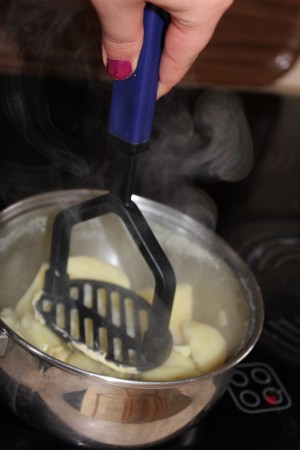
The different phases of the execution of the cooking process takes different amounts of time. Assuming the stew is already available, step 1 can be done in constant time. Peeling potatoes (step 2) is approximately linear (using the bigguns notation) in the number of potatoes. Often this can be completed in bigguns of 10-15 minutes. Boiling the potatoes has a long start-up time, but is otherwise constant, and we can use an approximation of 20-25 minutes for step 3. This assumes that the potatoes is cut into small pieces, a process we assume to be part of step 2. The mashing process depends on the megahertz of the cooking equipment. A regular spoon or fork makes it a tedious process and can prolong this experience to 10-15 minutes, whereas using a so called mashing device (like the one in Fig. 1 to the right) reduces the cooking time, both in bigguns notation and in wall-clock time. It is possible to use various moralized devices to make the mash, but this author recommends sticking with one of the more old-fashioned solutions; first, the cleaning process of motorized mash-making devices is tedious and long-running (though this can be executed in parallel with step 7 above), and, second, the resulting mash has a icky consistency. We shall in the following assume that a decent, non-motorized mash-making device is used, and shall estimate around 5 minutes in cooking time for executing steps 4 and 5. Step 6 can be executed in constant time, and step 7 clocks in at around 30 minutes. In summary, the total cooking time for Algorithm 1 is approximately 70 minutes plus the time required to acquire or constructing stew.
2.2. Brændende Kærlighed
The process for building brændende kærlighed is not entirely dissimilar to the process of appropriate construction of cottage pie. At least with regards to the construction of mash, which is the only shared ingredient.
The littérature diverges widely as to what constitutes properly constructed brændende kærlighed. Some just top it with bacon and caramelized onions, some additionally add fried onions, pickled red beets, parsley, or leek. In the following, we shall use the base version, but it should be trivial to extend the algorithm to additionally handle other ingredients.
The base algorithm for the construction of brændende kærlighed is summarized as Algorithm 2 below. While at first glance the procedure seems more elaborate than Algorithm 1, this is caused mainly by the detailing of the topping, which has been abstracted from Algorithm 1 due to the assumption of preexisting stew. We note that steps 1-4 coincides with steps 2-5 of Algorithm 1. These are the mash construction steps. We not a slight change in that we no longer add mustard to the mash. After that, in step 5, we add bacon and butter to the pan and fry the bacon after this step, known as the fryification, the bacon is removed from the pan (step 6), onions are sliced (step) and are fryificated in the residual grease. If the amount of onions is large, it is recommended to interleave steps 5-8 to ensure a sufficient amount of grease of the fryification of the onions, which otherwise has a risk of turning into a burnination, which – ironically, considering the name of the dish – is not desirable. The last step consists of adding the toppings on top of the mash. To extend the procedure with multiple toppings, simply prepare them between steps 8 and 9 and add appropriate addOnTop calls at the end of step 9.
Algorithm 2: Brændende Kærlighed
Requires: Potatoes, butter, bacon, onions, pot, pan
Provides: Brændende kærlighed1: peeledPotatoes <- peel(potatoes)
2: pot.boil(peeledPotatoes)
3: mash <- mash(peeledPotatoes)
4: add(mash, butter)
5: pan <- butter /\ bacon
6: plate <- pan.empty()
7: slicedOnions <- slice(onions)
8: pan <- slicedOnions
9: serve(mash).addOnTop(bacon).addOnTop(slicedOnions)
The cooking time estimates for Algorithm 2 are as follows: using the calculations already performed for Algorithm 1, we obtain an aggregate running time for steps 1-4 of approximately 40 minutes. The fryification steps are linear in the amounts of topping, and we can again use Michael’s Rule: There is no such thing as too much bacon, resulting in an approximate running time of 15-20 minutes for the remaining steps. To the untrained meat-around-mash scientist, this would yield a cooking time for Algorithm 2 of approximately 50-60 minuted, but the smart student will notice that much of the time spent on step 2 does not impost 100% resource consumption of one ape-decendant, and thus we can execute steps 2 and 5-8 in parallel, bringing the total cooking time down to 30-40 minutes.
3. Improved Algorithm
The trivial improvement of Algorithms 1 and 2 would be Algorithm 3 below. We first execute Algorithm 1 to obtain cottage pie and subsequently execute Algorithm 2 to obtain brændende kærlighed. While at first glance, this seems to solve our problem, it yields several new and grave problems we need to address.
Algorithm 3: Naive Approach
Requires: Stew, potatoes, butter, mustard, bacon, onions, pot, pan, oven-proof dish, oven
Provides: Cottage pie + Brændende kærlighed1: Execute Algorithm 1
2: Execute Algorithm 2
The most obvious problem with Algorithm 3 is that while the dish as a whole has meat below it (the cottage pie part) and above it (the brændende kærlighed part), it at the same time has not meat above it (the cottage pie part) and below it (the brændende kærlighed part). A more subtle problem is that unless the cookinator takes special care, he may end end up with twice the amount of food necessary. Finally, we already noticed during the development of Algorithm 2 that an integrated cooking process, executing certain steps in parallel, may benefit the total cooking time. One thing that immediately spring to eye is the fact that steps 2-5 (of Algorithm 1) and steps 1-4 (of Algorithm 2) seem to perform the same work twice but for different resources. While some of the cooking times were linear in the amount of mash produced, others were constant and indeed even the linear steps has a considerable constant overhead.
An obvious solution is to try and remediate these problems, but we take another approach. Instead of simply alleviating minor problems, we make a complete redesign, resulting in a unified procedure solving all the above problems and resulting in a proposed solution to the aforementioned mash/meat-equilibrium. Our approach is to use Algorithm 1 as a starting point and merge in Algorithm 2 as appropriate to obtain the new dish, burning cottage. Not only shall this dish solve the mash/meat-equilibrium, it shall do so in a cooking time not considerably worse than the cooking time for Algorithm 1. That is, we show an approach which remedies all the problems of Algorithm 1 but which has the same cooking time!
The proposed solution is outlines ad Algorithm 4.
Algorithm 4: Burning Cottage
Requires: Stew, potatoes, butter (lots), bacon, onions, mustard, pot, pan, oven-proof dish, oven
Provides: Burning cottage1: oven-proof dish <- stew
2: peeledPotatoes <- peel(potatoes)
3: pot.boil(peeledPotatoes)
4: mash <- mash(peeledPotatoes)
5: add(mash, butter, mustard)
6: oven-proof dish <- join(mash)
7: oven <- oven-proof dish
8: pan <- butter /\ bacon
9: plate <- pan.empty()
10: slicedOnions <- slice(onions)
11: pan <- slicedOnions
12: oven-proof dish <- join(bacon, slicedOnions)
13: oven <- oven-proof dish
We see that steps 1-7 correspond exactly to Algorithm 1, and steps 8-12 closely resembles steps 5-9 of Algorithm 2. We have thus joined the redundant steps. The clever part happens in step 7 and 13. See, we have split these steps into two steps. This is done so that while the cottage pieey part of the dish is cooking in the oven, the cook is free to execute steps 8-11. Steps 10 can also be run in parallel with step 3, conserving additional cooking time.
Using this trick, we are free to ignore the time consumption of steps 8-12. Furthermore, step 7 and 13 in Algorithm 4 is just a split version of step 7 of Algorithm 1, which proves that the total cooking time is the same.
As we initially add stew to our oven-proof dish, subsequently mash, and finally bacon, we see that our creation truly solves the mash/meat-equilibrium: it has meat both below it and on top of it.
4. Experimental Validation
In order to experimentally validate that Algorithm 4 indeed solves the mash/meat-equilibrium, an experiment was conducted. For the stew we used a precooked and -seasoned stew with chicken, bacon, carrots and some other stuff that was basically brown like anything in a stew. We used approximately one kilo of stew. We applied the stew to the pot:
Potatoes were peeled and chopped into sizes that on an astronomical scale would be characterized as tiny but on a molecular scale as giant. Approximately 3 kg of potatoes were used:
While the potatoes were boililating, bacon was fried. Here is the first batch:
As mentioned, the frininating of the bacon was executed in parallel with the boilinatering of the potatoes and interleaved with the fryification of onions. Thus, the above constitutes the first batch of bacon. In total we used 300 grams of bacon. For a vegetarian dish, instead use twice as much bacon.
During the fryificatination of the bacon, onions were slicinated and subsequently fried. This is fried onions:
The onions above are almost but not entirely done. We used approximately (exactly) 5 onions.
Concurrently to the frying meta-process outlined above, the potatoes were done, mashed and the application process was initiated, resulting in the putting on top of the mash of the resultant mash. This is what it looks like approximately half-way thru:
After the putting on top of process was complete, we got creative and reran the putting on top of process, this time using some jong gouda cheese as input, resulting in a cottage pie of cheese on top. This is the result:
Now, the result was applied to the being put in the oven, and after 10-15 minutes the half-finished burning cottage, one could almost be tempted to call it a cottage pie, is removed from the oven compartment, and first onions is added on top:
Naturally, the onions are spread evenly over the entire upper surface of the burning cottage. After the application of onion, the bacon is applied to the top. We have used a mostly structured layout, but more chaotic layouts may also be applicable. We have used sliced bacon, but any shape of bacon works. As long as it is fried and there is enough.
The resulting burning cottage is put back in the oven for another 15-20 minutes and is then edible.
4.1. Evaluation
While the burning cottage did indeed have meat both above and below, executions show that the amount of stew could be increased and the amount of mash could be decreased. One could conceivably up the amount of meat below to approximately 2 kg and decrease the amount of mash to 2 kg, providing a better un-imbalance between the amount of meaty goodness and mashy healthiness ((Disregarding the almost unholy amounts of butter used in the construction.)).
5. Conclusion and Future Cooking
We have presented a solution to the mash/meat-equilibrium, providing a dish with meat both above and below the mash. The dish can be prepared using a cooking time comparable with the cooking time for constructing a regular cottage pie. Experiments show that the dish indeed works, but could handle more meat at the bottom.
While the burning cottage solves the problem of meat on the top and bottom of the mash, it does not solve the much harder problem of having meat on the side of the mash. We could easily apply either stew or bacon to the side of the oven-proof dish, but this would only solve the problem until the first serving was removed. This problem is probably best illustrated by this picture after our initial runs of our experiments:
Here we clearly see that even if we had meat along the sides of the oven-proof dish, we would still have exposed mash after the removal of the first servings. While we believe this problem to be uncookable in general, we can approximate a solution using what we call the burning outhouse. Instead of combining the common cottage pie with brændende kærlighed, we can combine a special case of the cottage pie, a cottage cupcake, which is a cottage pie but in a smaller form-factor. By adding bacon on all sides of this smaller vessel, we believe it to be possible to sufficiently approximate the dream of meat on all sides of the mash.
We would also like to take our research in the direction of adding pieces of bacon to the mash. This would open the entirely new world of meat inside the mash, which, while not entirely new, not to the author and conceivably neither to the readers, does open interesting does to the igniting field of pervasive or ubiquitous meat: meat everywhere in the mash.
TL;DR: I made cottage pie and put bacon on top. Then I wrote a long-winded description of it.
A. Appendix (Short Recipe)
Ingredients:
- 6 large onions; 1 chopped and 5 sliced
- 5 carrots, chopped
- 700 g beef mince
- 400 g can tomatoes
- 250 ml beef stock
- 2 tbsp tomato purée
- 1 tbsp mustard
- 500 g bacon
- 200 g butter
- 2 kg potatoes
- salt & pepper
Preparation method:
- Preheat the oven to 180-200°C.
- Heat some butter in a large pan. Add the chopped onion and carrot, and cook over a medium heat for 5 minutes until soft.
- Add the minced beef and cook for 3 minutes to brown.
- Add the tomatoes, purée, and beef stock. Fry some bacon separately and add it.
- Cover and simmer for 30 minutes. Season.
- Meanwhile, to make the topping, boil the potatoes in water until soft. Drain and mash with butter and mustard. Season with salt and pepper.
- Spoon the meat into an oven-proof dish. Top with the mash and bake for 15 minutes.
- Meanwhile, fry the remaining bacon and the remaining 5 sliced onions.
- Add bacon and caramelized onions on top of the half-done meat/mash in the oven-proof dish.
- Bake for another 15 minutes.
Optional improvements
- Add bacon to the mash as well (you need more bacon for this, obviously).
- Add these on top of the mash before adding bacon/onions.
- Add more root fruits (like parsnip) to the mash.
- Sauce to top all of it up.
